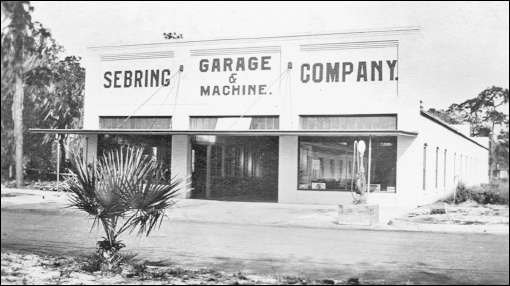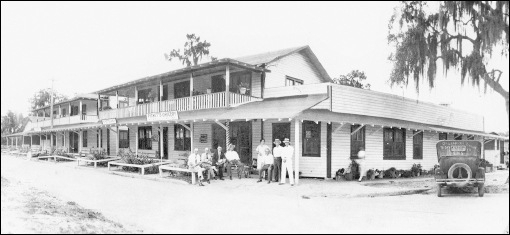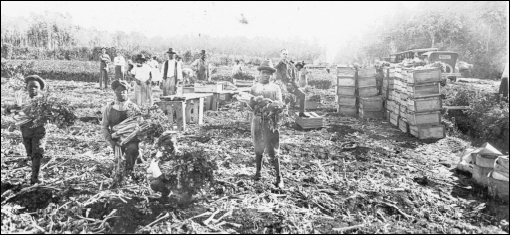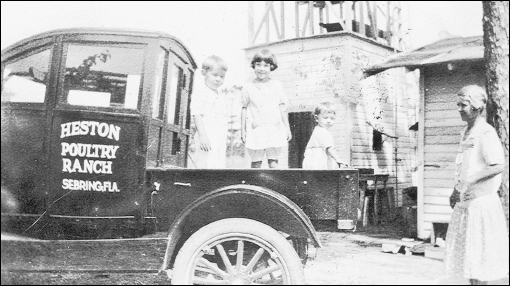Six
BUSINESS AND AGRICULTURE

I. L. Jenkins opened his brick plant in May 1912 on the Atlantic Coast Line Railroad right-of- way. According to John F. Newcomb, one of the first to observe the workings of the new plant, the Arrowhead Hotel was the first building to use Jenkins’s air-dried bricks the next month in its foundation. The three youngsters in this photograph are, from left to right, Landis Jenkins, and Fred and Harold Newcomb. (Courtesy Sebring Historical Society.)

The Sebring Garage and Machine Company was located on North Ridgewood Drive between North Mango Street and the Circle. In 1924, the garage sold Overland Touring cars for $495. This photograph was taken before 1923 when the Hainz Building was constructed immediately south of the garage. See pages 32 and 33 for photographs of the garage adjacent to the Hainz Building. (Courtesy Sebring Historical Society.)

The open-air Dowling Gas Station, which sold Crown Gasoline from aboveground barrels, is shown in this c. 1925 image. The Dowling family also owned Dowling and Newsome Realtors. The youngsters at left are (from left to right) Grafton Geddes Dowling Jr. (1915–2001) and Joab Mauldin Dowling (1917–1992), both of whom practiced law in South Carolina for many years. The car has a decorative “Sebring” sign on the grill. (Courtesy Sebring Historical Society.)

Vern Cunningham is seen behind the wheel of a Ford Model T truck belonging to Milt Baker’s block plant, which in 1926 was located at the north end of Pine Street. Among Baker’s many other enterprises were his grocery store, the Ohio Movie Theater, and a Nash automobile agency. He was active in local governance as a member of the town council from 1936 to 1939. (Courtesy Sebring Historical Society.)

Moyers Café was located in downtown Sebring. The family also owned Moyers Garage in the old Ohio Theater building (1922) at the corner of South Ridgewood Drive and Magnolia Avenue. In the 1930s, Moyers Garage sold Sinclair H-C Gasoline and Good Rich tires, and serviced Pontiac automobiles. (Courtesy Sebring Historical Society.)

Pickett’s Grocery and Boarding House was built in 1926 on Orange Street. In July 2001, Louise Pickett Smoak reminisced in The Historian about growing up in her parents’ boarding house, which included “two two-storied buildings with 16 smaller houses in the back.” John S. and Claribel Spencer Pickett operated the venture together, and after his 1928 death, Claribel supported her family with the business. (Courtesy Sebring Historical Society.)

Situated at the corner of North Ridgewood Drive facing North Mango Street, Mark’s Service Station—“The Greasing Center of the City”—and Mark’s Café, featuring homemade pies, were close to the post-1927 action. The Central Fire Station is clearly visible in the distance, and the Sebring Garage and Machine Company building is at far right. (Courtesy Sebring Historical Society.)

Kahn’s Department Store, for many years, was the largest and most complete upscale department store in town. A double-front store in the Nan-Ces-O-Wee Hotel, it was owned by Michael “Mike” and Sadie Kahn, who arrived from Georgia in about 1921. The Kahns were founding members of Temple Beth Israel, and organized a Passover Seder for servicemen from Hendricks Field and the Avon Park Base in the 1940s. (Courtesy Sebring Historical Society.)

The men’s section of Kahn’s is shown in this image from 1940. Abraham Jacob (A. J.) “Bucky” Kahn managed the store from 1949 until it closed in the mid-1960s. Bucky was a member of the Sebring Lions Club for 48 years and a past district governor. Mike and Sadie Kahn’s other children included Leon, Marvin, and Ruth Kahn Davis; all were successful and held in the highest regard. (Courtesy Sebring Historical Society.)

Muff’s Bakery was owned from the early 1920s by Bill Muff. His sons Harris (a member of the Sebring Fire Department in the 1920s) and Anvil did not remain with him in the business and eventually moved from Sebring. This photograph from 1940 shows Anvil Muff and his wife in the bakery with customer Ruth Amy (Mrs. Payne) Sebring. (Courtesy Sebring Historical Society.)

The Merry Go Round Restaurant on the east side of North Ridgewood Drive at the corner of Lime Street is shown in this photograph from 1944. This popular hangout for high school students was managed by Mrs. Barlow; her husband ran the Gulf gas station across the street and Barlow’s Taxi service. (Photograph by Ted Shoemaker, courtesy Sebring Historical Society.)

In 1936, George Lilly’s dance hall and tavern was located on Lakeview Drive along the south shore of Lake Jackson on property now home to the VFW Club. During World War II, the tavern was a popular spot for military personnel and locals, who enjoyed music provided by high school students and musicians from Hendricks Field. (Courtesy Sebring Historical Society.)

The well-stocked Peters Five and Dime Store was located on North Ridgewood Drive. This photograph was taken on January 5, 1945, and shows the staff, (from left to right) Mr. Peters, Mrs. Peters, Myrt Foster, unidentified, Betty Foster Witt, and Muriel Odell Phelps McGee. This week featured a 1¢ sale on Colgate Tooth Powder. (Courtesy Sebring Historical Society.)

A crowd gathered for the grand opening of L. D. Poer’s Chevrolet dealership at North Ridgewood Drive and North Pine Street in May 1950. The dealership had been in business since at least the early 1930s. Poer was active in local governance, serving on the city council from 1940 to 1943. This building is still standing. (Courtesy Sebring Historical Society.)

Yarbrough’s Drugs was located on North Ridgewood Drive at the south end of the Hainz Building next to the Salvation Army Building. This August 1, 1951, photograph shows shoppers at the grand reopening after a fire. This storefront was Manley Drug Company in the 1920s, and after Yarbrough’s, it was home to (Roy) Gilbert’s Drug Store. (Courtesy Sebring Historical Society.)

Noah B. “Bill” Graybill (1912–1985) is seen in the Sweet Shop on the Circle in Sebring adjacent to the Circle Theater in this photograph from early 1951. The newsstand was conveniently located and catered to those with a sweet tooth. Graybill was an active member of the Sebring Firemen, served on the city council in 1958 and 1959, and managed the Sebring Air Terminal. (Photograph by Ted Shoemaker, courtesy Sebring Historical Society.)

The Eighth Air Depot was formed by Arthur N. Dorman, George Dumont, and Bob Kiel after World War II. Audrey Vickers wrote in 1985 that the company hired hundreds of people and was in the business of overhauling airplanes. They utilized space at the decommissioned Hendricks Field and were vitally important to the airport and local economy. The firm was sold in 1969 to Support Systems, Inc. (Courtesy Sebring Historical Society.)

Jim Blackman operated the local Ford dealership beginning in the mid-1950s. Blackman was supportive of local school groups, and in the 1960s, he donated a van to the Sebring High School band. Shown from left to right are Raymond Clarke, Joan Masters, Jim Blackman, band director Paul Gustat, Wally Cox, and Joe Poff. (Courtesy Sebring Historical Society.)

A graduating class from Sebring High School is feted by the employees of Tropical State Bank in this 1960s photograph, a tradition fondly remembered by members of many classes. The bank, chartered in 1925 in Lake Placid, moved to Sebring in 1934 and changed its name to Tropical Bank and Trust Company on January 9, 1965. It was later purchased by Barnett Bank. (Courtesy Sebring Historical Society.)

Established in 1918, the cooperative Sebring Citrus Fruit Growers Association packinghouse was integral to the local citrus industry. Sebring was surrounded by groves, and eventually Highlands County was to become the center of the state’s citrus industry. The plant burned in October 1923 with damages estimated at $75,000. (Photograph by Field, courtesy Sebring Historical Society.)

The interior of the Sebring Citrus Fruit Growers Association packinghouse was the scene of this c. 1920 photograph. Incoming fruit was sorted by size and quality, and the best were individually wrapped in printed tissue paper. Colorful citrus crate labels were promotional and informative, indicating the origin and quality of the citrus. The Sebring Sealdsweet brand label featured an illustration of Kenilworth Lodge. (Photograph by Field, courtesy Sebring Historical Society.)

Employees from the Lakemont Packing Company are shown in April 1929. Gregg Maxcy, a member of a prominent central Florida citrus family, owned the company. In 1932, Lakemont packaged fruit under the Perfect Number 7 label. A label used by both Lakemont and the Sebring Citrus Growers was Speed brand. Gregg Maxcy also sold fruit under the Ladye and Leader brands. (Courtesy Sebring Historical Society.)

This image shows members of the Sebring Citrus Fruit Growers Association in April 1929, which at this time was affiliated with Gregg Maxcy. In The Seventy-Five Years of Sebring, Tim Hurner wrote that “Citrus has been the premier agricultural crop in Highlands County. The acreage has almost doubled over the past twenty five years, with most of that increase coming in the sixties and early seventies.” (Courtesy Sebring Historical Society.)

Payne M. Sebring and Leland Keck organized the Sebring Packing Company in 1942, the same year the Florida Citrus Exchange closed the Sebring Fruit Growers Association cooperative, which had been in operation since 1918. The new company, headquartered on Pear Street, provided a stable outlet for local growers to market their fruit. This photograph shows boxes of Valencia oranges stacked for shipping. (Courtesy Sebring Historical Society.)

Citrus was not the only agricultural product grown in Highlands County. The wide variety of produce included avocados, cabbage, caladiums, celery, Easter lilies, peppers, pineapples, tomatoes, winter beans, and many more. This December 16, 1926, view shows Jesse Vaughn (center) in his pepper patch with Louis Alsmeyer (right), Highlands County’s agricultural agent from 1926 to 1944. Alsmeyer also managed an agricultural fair near Lakemont with A. L. Butler in the 1920s. (Courtesy Sebring Historical Society.)

A celery farm crew pauses for a photograph in the 1920s near Sebring. In the 1930s, Rex Beach operated a celery farm, one of his many agricultural interests. The gladiola and Easter lily farm he and his wife, Edith Greta Crater Beach, owned was especially profitable, earning an estimated $1 million. (Courtesy Sebring Historical Society.)

Writing in April 2007 in The Historian, Sebring native Bill Schlosser recalled that the Radebaugh pineapple farm was “about where Alan Jay Chevrolet is today. Then a little south of that was Grotewold Pineapple field.” According to Allen C. Altvater, “one of the Gearing boys had a lot on North Lakeview planted solidly in pineapples and on all four sides, signs, complete with skull and crossed bones, warned ‘These pineapples are poison.’ ” (Courtesy Sebring Historical Society.)

In 1927, the Heston Poultry Ranch truck was full of young helpers. As early as 1936, the South Florida Motor Company supplied heavy-duty farm equipment to the Sebring area, including tractors, harrows, sprayers, and irrigation equipment. The company was owned by Smith J. Rudasill and his son Smith Jr., who served many terms as mayor. (Courtesy Sebring Historical Society.)

This photograph shows Oscar Spivey’s Kenilworth Dairy, located close to present-day Villa Road on the east side of Lake Jackson. According to the Greater Sebring Chamber of Commerce, over 60 percent of present-day Highlands County lands are used for cattle grazing, a total of some 425,000 acres. Annual gross sales exceed $31 million. (Photograph by E. G. Burton and Son, courtesy Sebring Historical Society.)

Owner Ted Farr is shown outside Farr Feed and Seed, perhaps in the 1950s. The store supported the local agricultural community, including crop farming and the livestock trade. It sold fryers, hens, and eggs, and advertised Security Feeds poultry feed, manufactured by a company in Knoxville, Tennessee. The Sebring Feed Store was located on South Commerce Avenue and was established in 1940. (Photograph by Ted Shoemaker, courtesy Sebring Historical Society.)

The 1951 Highlands County Cattlemen Association Round-Up was a big event. Attendees included, from left to right, (first row) B. Waggaman, ? Stokes, G. V. Hudson, P. G. Gearing, A. Munson, three unidentified, J. McKenzie, and two unidentified; (second row) unidentified, Maebelle Abney, Broward Coker, two unidentified, E. H. Norris, unidentified, Bucky Kahn, Dot Sauls, Jimmy Creel, Fisher Sauls, and unidentified. B. G. Collier is in the far upper right. (Photograph by Ted Shoemaker, courtesy Sebring Historical Society.)